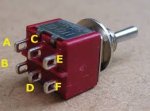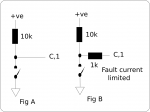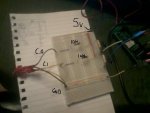You are right Westaust55 and I didn't seek to contradict you, but failed to read your post comprehensively. Sorry.

It seemed that the carcase had been well mauled before your post.
JM appeared confused and, had the AXE031 documentation been brought up to date to reflect that it is now supplied with an 18M2, then it would just have been a how do I wire the switch problem. Indeed the board sounds quite useful but obviously there are more important things going on just now.
I signally failed to pickup on the switch contacts that you had suggested and if I had been a little more astute I would have noticed and gone with the flow instead of suggesting the alternative contact set. I had picked up that JM wanted the pin to be active high and so did go with that.
Hopefully JM has the message, one way or another and someone at Rev Ed will find a little time to squeeze the alternative pin header description into the AXE031 datasheet to clarify things for potential users who might otherwise have difficulty making the proper connection.
To myself, not familiar at all with the terminal nomenclature used with the Picaxe 18X, the labelling of the header initially appeared to refer to attributes of the AXE031 and not necessarily the chip hosted by it. By that time I had Manual #1 open at pages 9 and 10 for chip pinout comparison, the AXE031 datasheet for the pin header diagram and quickly scanning the complete thread for what may have been solved already. With the exception of your own response, I wasn't really convinced that JM was going to be sufficiently tuned in to solve his problems.
Sometimes when you don't know how to do something and the subject is relatively new, then it is difficult to concisely express the problem and so we end up with a lot of noise as well as the pearls, missing the multiple natures of the difficulty being experienced; namely how to configure a switch (schematically) or in this case a specific switch. The header pin layout wasn't explicitly queried, to the best of my recollection (I'm typing so won't try to go back and look) but I figured that it was a significant stumbling point.
Something in this thread for all of us and not just JM perhaps?

As a regular noise maker, should I be tiptoeing quietly towards stage left?
I did stop to consider my perceived toggle switch conventions - US down is OFF (can be slammed down in an emergency), UK down is ON - well it used to be a few aeons ago!
Is it working now JM and if not what do you need to know. Your public awaits!



